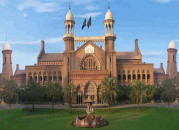Animal hide prices plummet to new lows
Sharp decline dampens charitable organisations’ interest in hide collection
1718636454-1/Eidul-Azha-2024-(12)1718636454-1-640x480.webp)
Sacrificial animal hides, the once highly valued commodity and a significant aspect of Eidul Azha, are experiencing a dramatic decline in prices, resulting in diminished interest from charitable organisations.
This year, the price of ox hides dropped to an astonishingly low range of Rs1,200 to Rs1,500, compared to previous years when they fetched between Rs15,000 and Rs17,000. Despite the decline in hide prices, the cost of purchasing an ox remains high, starting at around Rs0.5 million.
Similarly, the price of goat leather has plummeted, now selling for only Rs300 to Rs500, down from the previous range of Rs800 to Rs900. The expense of sacrificing a goat, however, remains substantial, with prices ranging from Rs70,000 to Rs80,000. This sharp decline in hide value has caused charitable organisations to lose interest in collecting them, a practice that once provided a significant source of funding for their philanthropic activities.
In past years, the collection of sacrificial animal hides was a top priority for charitable organisations. Collection camps were established with formal permissions from the district administration, and banners were displayed, urging citizens to donate hides. These organisations would then sell the collected hides to generate funds for their charitable activities.
In cities like Karachi, the competition among charitable organisations to gather the most hides was intense, sometimes leading to physical confrontations between rival groups. However, with the plummeting prices, the fervour and competition have waned significantly.
In contrast, the business of roasting sacrificial animal thighs (Raan), cleaning trotters (Siri Paya), and preparing mincemeat has reached its peak during this festive season. Affluent households often delegate the preparation of various dishes to hotels, where employees deliver the meat to be cooked and then return home with the hotel-prepared dishes.
Middle-class families, however, take a more hands-on approach, with women typically responsible for preparing their favourite dishes.
During the first three days of Eidul Azha, the markets are bustling with activity as people engage in the preparation of delectable dishes from the sacrificial meat. Shops offering services for roasting and cleaning trotters, as well as mincemeat preparation, are crowded with customers, yielding substantial profits for the vendors. Citizens also flock to hotels that provide meat-roasting facilities, making it a busy and delicious festive season.
After the initial day of sacrificing and storing meat in refrigerators and deep freezers, families now focus on serving the stored meat to their loved ones. The tradition of enjoying various meat dishes prepared from the sacrificial animals remains strong, even as the value of the hides has declined. Despite the economic shifts, the spirit of Eidul Adha continues to thrive through culinary celebrations and communal feasting.



















COMMENTS
Comments are moderated and generally will be posted if they are on-topic and not abusive.
For more information, please see our Comments FAQ